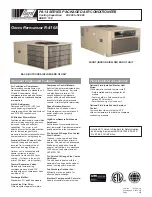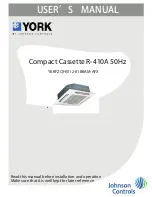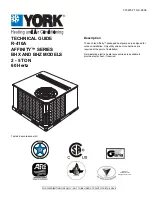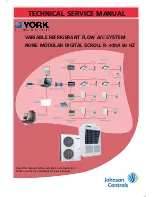
Service and Maintenance
188
RT-SVX24J-EN
Final Process
Record the unit data in the blanks provided.
Table 61. Evaporative Condenser Models—Maintenance and Troubleshooting
Maintenance Schedule
Component
Action
Frequency
Comments
Fan Motor
None Required
Non-grease bearings
Sump Pump
Inspect / Clean
1 – 2 times per year
Clean inlet openings to pump
Sump
Inspect / Clean
1 – 2 times per year depending
on water hardness and unit run
time
Sump can be drained and hosed out using hose bib
provided at water fill solenoid valve. Vacuuming scale out
is an alternate method
Sump Float Switch
Inspect
1 – 2 times per year
Float should be free for full float travel
Sump Float Make Up
Valve
Inspect for proper water
level
1 – 2 times per year
Spray Nozzles
Inspect / Clean
1 – 2 times per year
Inspection through access panel
Conductivity Sensor
Inspect / Clean
1 – 2 times per year
Clean sensor to ensure accurate readings
Conductivity Controller
Inspect / Recalibrate
1 – 2 times per year
Recalibrate controller
Troubleshooting
Component
Problem
Check
Fix
Fan Motor
Does not run
Condenser Fan Relay closure and
control voltage indicating a call
from compressor control panel
for the condenser fan to operate.
Sump Pump Overload Trip. Fan
Motor Overload Trip. Fan fuse
trip.
Check each motor overload and reset if necessary.
Check amp draw for each leg.
Sump Pump
Does not run
Sump Pump Overload Trip Low
Water Level or faulty float
switch. Unit in ‘Dry Mode’
Operation
Reset – check amps on each leg to determine if faulty motor.
Check and clean debris around float switch. Check Ambient
thermostat setting and mode of operation (close on rise).
See section 2 for T’stat setup instructions.
Sump Pump
Low Flow
Pump may be operating
backwards or impeller inlet may
be slightly blocked.
Change pumping direction by changing any two legs to the
pump motor. Disconnect Power and remove pump to inspect
for possible impeller obstruction.
Spray Nozzle
Dry area on coil
Check for proper spray pattern
over each quadrant.
Remove debris from clogged nozzle.
Table 62. Unit Data Log
Complete Unit Model Number:
Unit Serial Number:
Unit “DL” Number (“design special” units only):
Wiring Diagram Numbers (from unit control panel):
-schematic(s)
-connections
Network ID (LCI/BCI):













































